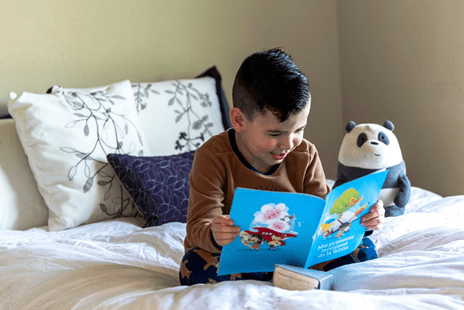Should We Practice Sight Words With Preschoolers?
Preschool: a place for show & tell, songs, coloring books, and learning how to read. If you’re the parent or educator of beginning readers, you might be wondering: should we teach reading, and more specifically, “sight words” in preschool? And if you’re entirely new to preschool education, it’s just as acceptable to ask: what are sight words?
Today, we’ll use experts’ advice to answer these questions, offer strategies for practicing sight words, and outline the best sight words for preschool and kindergarten classrooms.

What Are Sight Words?
Sight words can be recognized instantly: they’re simple words that a reader can “see” and pronounce without sounding out or guessing. An early reader’s set of sight words will vary slightly, as every preschooler or kindergartner is exposed to different books and varied sets of sight words. That said, most sight words are high frequency words that appear regularly in many children’s books. Think “the,” “a,”, “I,” “to,” and other words that aren’t easily sounded out but appear regularly in decodable books.
When to Teach Sight Words
Before practicing sight words with preschoolers, they should be showing signs of reading readiness:
- Holding books and turning their pages correctly, from left to right
- Ability to listen to a story, answer questions about it, and retell a familiar narrative in their own words
- Alphabet knowledge: ability to recognize and sound out most letters
- Phonemic awareness!
The final point is especially important. Learning to read is not simply a matter of practicing sight words. Before presenting a list of words to your preschooler or kindergartner, they should have a solid foundation in phonemic awareness: the ability to sound out the individual sounds in words. A preschooler who can blend simple sounds - /c/ /a/ /t/ to produce the word “cat,” for example - may be more prepared to memorize a list of preschool reading words than a kindergartner who is not as advanced in their phonemic awareness. In the realm of sight words, patience is key: your kindergartner may be more advanced than your struggling first grader, and this is simply part of the reading journey - not a determinant of either child’s long-term reading success.

What Are the Best Sight Words?
With time and exposure to more books, young readers will develop their phonemic awareness. They’ll be able to count syllables in words, rhyme, and identify the first and last sounds in a word. At this point, you can craft or modify a list of the best sight words. These lists vary among reading experts and can also be modified to include high-frequency words in any decodables you plan to read with your child. That said, some of the best kindergarten sight words include:
- Can
- Am
- Are
- At
- Do
- For
- Go
- Has
- Have
- He
…Just to list a few! Note that these lists can be modified and expanded based on the needs and skills of the child. For pre-K or “pre-readers,” Readsters recommends these preschool reading words:
- The
- A
- I
- To
- And
- Was
- For
- You
- Is
- of
Like any skill, a mix of repetition and learning new concepts is essential. If your child is reading-ready, practicing sight words on a daily basis will enhance their reading fluency, phonemic awareness, and overall confidence.

Take-Aways
- Sight words can be used to increase reading fluency in a child who is ready to read.
- Signs of reading readiness include understanding how to hold and read a book from left to right, alphabet knowledge, ability to listen to and retell stories, and phonemic awareness.
- Phonemic awareness is an especially important foundation to establish before practicing sight words with preschool- and kindergarten-aged students.
- The best sight words for early readers will vary depending on their skills and access to decodable readers, but many experts offer lists of the best high-frequency words for pre-readers.
Start Teaching Reading for Free Now!
Access Level 1’s four interactive stories and the accompanying supplemental resources to teach elementary students how to read. No credit card is needed. Join the 42,635 teachers and students using our reading program.

 The ability to read is a life-changing skill. It opens up new worlds, new opportunities, and new relationships. Research has shown that children who have strong reading skills are more likely to succeed in school, to start their own business, and lead happier lives. Sight words are the most important tool to build vocabulary and to acquire reading fluency. They account for 75% of English language usage. They are also the words that we use most often. Learning the easy ways to teach sight words is essential to the teachers that helps the kids to master reading skills.
The ability to read is a life-changing skill. It opens up new worlds, new opportunities, and new relationships. Research has shown that children who have strong reading skills are more likely to succeed in school, to start their own business, and lead happier lives. Sight words are the most important tool to build vocabulary and to acquire reading fluency. They account for 75% of English language usage. They are also the words that we use most often. Learning the easy ways to teach sight words is essential to the teachers that helps the kids to master reading skills.